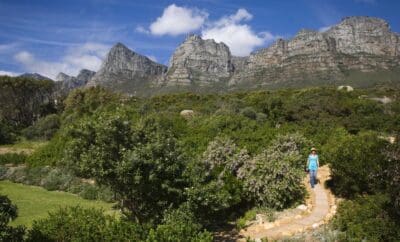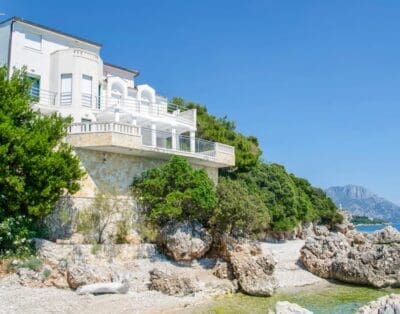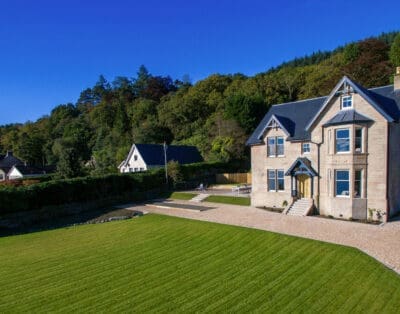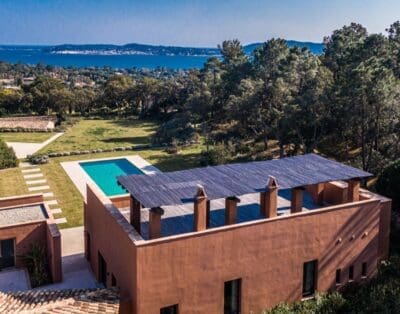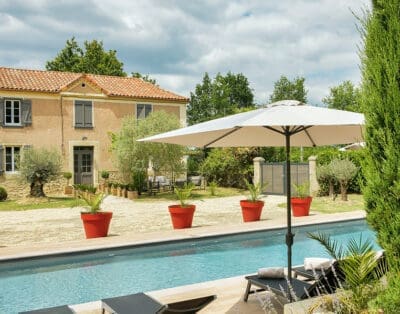Luxury Flying Safari in Namibia
Yves de Contades took off for a luxury flying Safari adventure to explore and discover the bounteous wildlife and breathtaking landscapes of Namibia.
You depart from Heathrow to Windhoek via Frankfurt to be met by a charming light aircraft pilot who flies you over the most stunning scenery to your first luxury lodge, the Kulala Wilderness Camp.
The people at the hotel greeted us with energetic singing and dancing whilst in the background there were stunning huts dotted across the lower slope on the southern side of the two-mile wide valley. Occasional small water holes were surrounded by birds with huge nests in the trees and Springbok and Oryx meandered across the savannah. The main hut and restaurant have a large wooden balcony with a beautiful little pool and a breathtaking view. We had lunch on the veranda and then our guide drove us off in the Land Rover to the other side of the hills to explore and afterwards catch the sunset on the edge of a vertical precipice looking out over a vast plain that burned with an orange grey light as darkness descended.
Following a lovely, if rather early, breakfast of local fruit and juice we set off to the Namib desert to see the giant sand dunes. The drive was magnificent through the Namibian Savannah along dirt tracks, not a surfaced road in sight, and prides of ostriches everywhere. Sossusvlei national park is a stretch of desert that goes up the Namibian coast for 2000 km and pushes in for 40 km, and is home to these amazing sand dunes, which have arrived there courtesy of the Kalahari desert. After an hour we reached the beginning of the sand dunes and set off on foot; Big Daddy, the largest dune, stands at 240 metres, dune 45 is 170 metres high and we sprang up it infused with energy endowed by the crystal clean air, however halfway up, as the sand took its toll, we slowed to a more amiable pace. Everything resembles over-saturated film, the blue of the sky and the orange-red of the sand create this surreal fantasy desert landscape; the deep, rich, glorious red comes from the rusted iron in the sand. The summit revealed a searing vista of undulating dunes stretching out into infinity topped by an acid cyan sky. The downward journey was decidedly easier and sliding down on feet and posterior was vertiginous and exhilarating, dune surfing with the waves of sand sweeping you forwards. We then walked out into the desert and after a kilometre of the most intense heat, reached a wide circular pan known as the Dead Vlei, which means dead valley; it is scattered with fossilised dead black trees in twisted shapes, and evokes a fictional martian landscape, it was used in the Jennifer Lopez film “Sell”.
Next stop was the Kulala Reserve for quad biking along the dry riverbed. Our guide showed us the safety procedures and we motored along the river bed which was pitted with gullies and rocks and the bikes bounced merrily up and down. As the sunset, the landscape turned a dark orange and then in the distance we could see a large rain cloud tearing towards us, dragging a dark curtain of sheet rain. It was fantastic riding through the torrential downpour along the rising river as the rain-spattered down so hard it hurt. The light was extraordinary: dark yellows, blues, pinks and golds scattered everywhere. As darkness fell the mood on the African plain became even more intense under the bike headlights as we raced through the puddles back to the lodge.
The following day we flew over the desert to Damaraland Camp in a Cessna 402. We took the scenic route of 750km, over endless giant orange dunes striated with rivers, via Swakopmund which is a tiny little resort town founded on the coast a hundred years ago. The pilot even circled over the skeleton coast and the wide river mouth that spouts out into the sea. We stopped to refuel at a brightly coloured airfield on the flat desert plains surrounded by bleached dunes in all directions.
After a fabulously warm welcome at the beautiful luxury camp Damaraland, we chatted with everyone and sat for dinner while the whole crew appeared and sang a welcome song and danced in the traditional style. This is followed by the Namibian national anthem and then by a jokey song that gets each of them dancing in front, while the others clap appreciatively with the person’s name following the word “sexy” sung high and loud. The menu is recited in English and in the Click language, which sounds fantastic as it uses four different glottal stops at the front, middle, back of the tongue and back of the throat with a loud smacking sound, impossible to copy if you were not brought up here.
The area manager for Wilderness looks like Lenny Henry’s sister and has a very laid back laugh; she will finish recounting a kind, moving and often personal story by putting her head back and chuckling deeply and throatily for two minutes or more. She grew up in one of the local villages and tended goats as a child, getting up at 7 am and milking them, then fetching water and milk for her parents’ breakfast. Subsequently packed off to the local boarding school at 7, as per the local custom. She spent the next few years there, returning at weekends. Her parents are traditional and expect her to wear the local garb and to bear 11 children as her mother and grandmother did. I
t seems that keeping men in the area is not easy, tradition dictates that a man pays the parents 20 cows for the daughter and few men can afford or wish to get married. After school she went to Windhoek to work and got a job with Wilderness Safaris, she has worked there 15 years and now runs three lodges. She has two children which like many of the women here she brings up alone as the men tend to leave for work elsewhere. Wilderness Safaris work very closely with the local villages. The locals own 40 per cent of the camp and after 15 years will own it all. The staff come from the villages and are trained by Wilderness.
It is a perfect example of intelligent economic cooperation, investing in the people and the land to build a decent future, however, it is changing the local culture which men have dominated for a long time. The women do all the work, but as the area manager says “they are getting smarter”, they are learning from the workplace and from the people they meet at the lodges that men and women can have a more equal relationship.
The next morning we are up early for the Elephant Safari. We head north which is where some elephants were spotted a few days ago. We pass a couple of the local villages with wooden kraals for the goats, cows and donkeys. The houses are traditionally made of mud and cow pats or more recently with canvas and aluminium. In one village we find four children corralled in a giant playpen surrounding a tree. Everyone here are co-owners of the tourist industry and very friendly, coming out to wave and say hello.
We head up the hills looking for elephant tracks and soon come across large spoor and footprints which indicate the elephants were here this morning and the direction they are heading. The chase is on. Soon our guide gets even more excited as he has spotted Black Rhino tracks, they are rare and it would be great to find one. There are only a hundred left in the area. Soon we come across more elephant signs, a pool of water that the elephant has dug with his foot to reach the water just below the surface.
Finally as we crest a hill we spot the elephants on the other side of the valley, there are six of them, though it is not a typical herd as they have large tusks which the locals do not, they are tusk-less.
The elephants are beautiful and a deep rich brown from the mud they immerse in to cool down. There is also a newborn baby, maybe 6 weeks old. The parents stay very close and move regularly to shield her from potential harm. They move gently along the sloping valley eating the grass as they go. The grass is known as Oryx tail as it is long and green with a fluffy silver top, better known as bushman grass. We picnic in the elephants company for an hour and then start back keeping an eye out for the Black Rhino. There are three local families of elephants in the area and many more bulls.
Elephant culture is fascinating if harsh. The daughter elephant is kept close to the mother and often helps bring up the children. The boy is part of the family until he reaches around 12-14 years old when he becomes more boisterous and troublesome. He is then pushed out and may follow the herd for months before eventually wandering off. The young bull then spends the next ten years alone apart from occasionally joining other bulls for company. When he is fully grown and in his prime, he will rejoin a herd to mate and dominate that herd as his father before him. Not so different from human culture when you think about it.
Namibia is breathtakingly beautiful and the people are warm and welcoming, it is an exciting land full of adventure and mystique, with luxurious lodges, wonderful service and genuine eco-credentials. Take a flying Safari for the trip of a lifetime and create some lasting memories you will recount to your friends again and again.
https://wilderness-safaris.com/
https://www.airnamibia.co.uk



